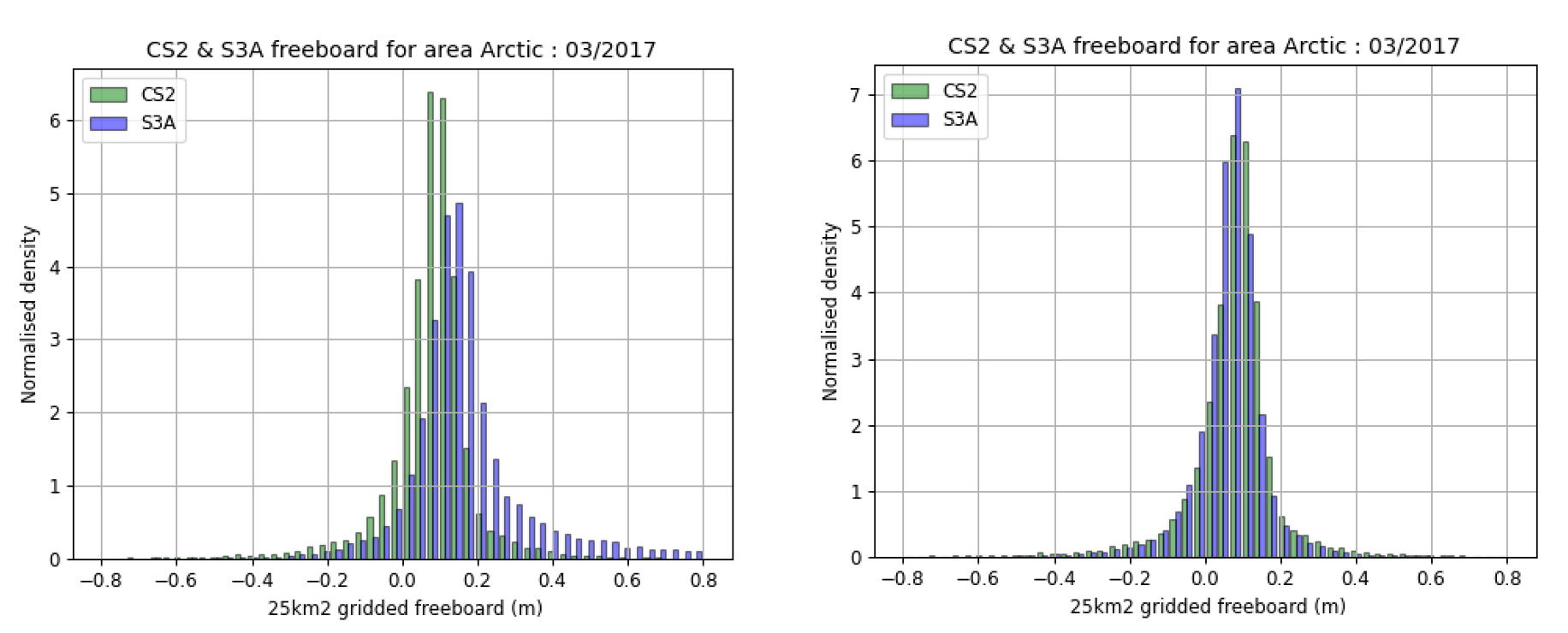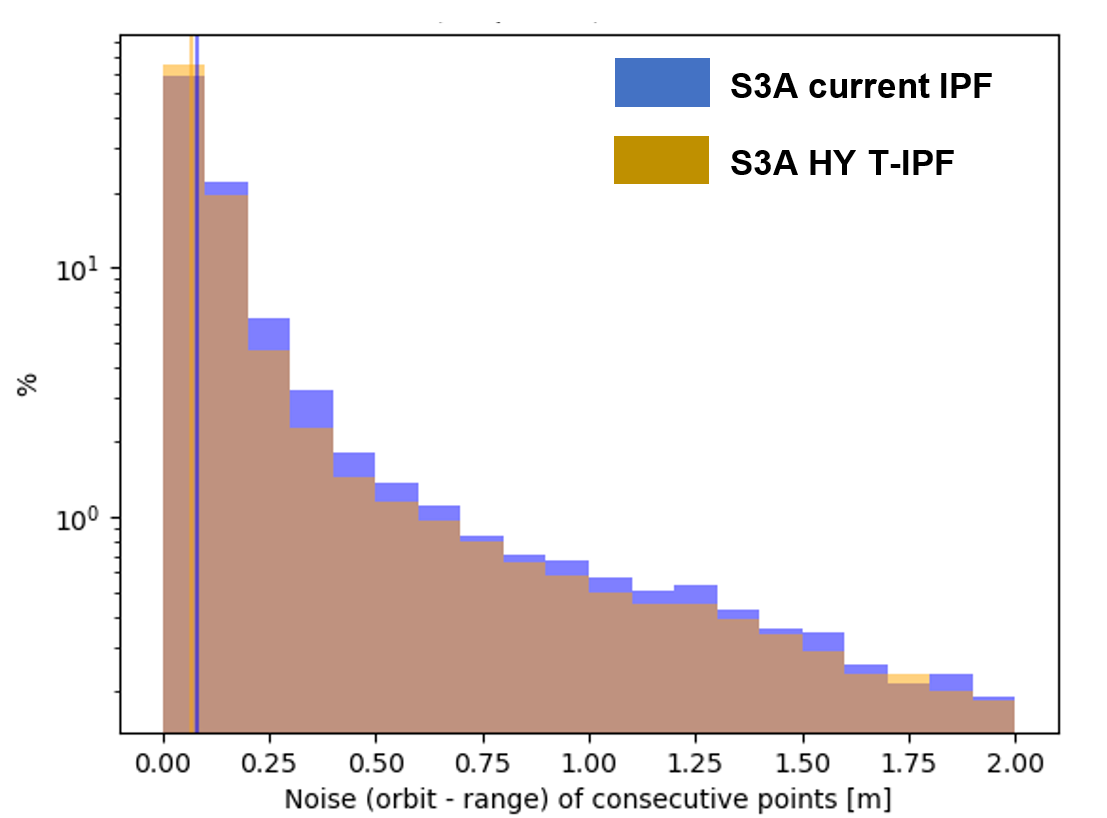ESA is pleased to announce the availability of Copernicus Sentinel-3 altimetry data set generated by the NEW ESA Sentinel-3 Thematic Instrument Processing Facilities (T-IPFs). Planned to be deployed in spring 2022 by the ESA Payload Data Ground Segment (PDGS), the LAND T-IPFs are dedicated and specialized delay-Doppler and Level-2 processing chains over Sea-Ice (SI), Land Ice (LI) and Hydrological (HY) surfaces.
ESA is pleased to announce the availability of Copernicus Sentinel-3 altimetry data set generated by the NEW ESA Sentinel-3 Thematic Instrument Processing Facilities (T-IPFs). Planned to be deployed in spring 2022 by the ESA Payload Data Ground Segment (PDGS), the LAND T-IPFs are dedicated and specialized delay-Doppler and Level-2 processing chains over Sea-Ice (SI), Land Ice (LI) and Hydrological (HY) surfaces.
The LAND T-IPFs constitute a major evolution of the LAND IPF, the current ground segment processor for the altimetry measurements acquired over continental areas. This deployment will represent a breakthrough in the data quality of the Sentinel-3 Surface Topography Mission (STM) LAND products. The development of separate delay-Doppler and level-2 processing for each of the three main continental surfaces will provide better flexibility to upgrade and evolve the processing chain and algorithms. With the T-IPFs, the specificities of the three thematic surfaces will be better addressed, to further improve the mission performances.
The TDS (see access information here below) was generated with the upcoming T-IPF processing baseline, which includes important and major evolutions as detailed below. For each of the three thematic surfaces, the altimetry measurements are delivered only over their area of interest. Compared to the current Sentinel-3 STM level-2 products, the format of the new T-IPFs level-2 products have significantly evolved. The document describing the new Sentinel-3 level-2 Product Data Format Specifications (PDFS) and a ReadME note atr available along with the TDS.
This TDS is released prior to the deployment of the T-IPFs, for the users to become familiar with the new product format and adapt their tools and processes in consequence. For any feedbacks or questions regarding this TDS, please contact: s3mpc-stm-user-request@groupcls.com
NB: The land ice TDS will be made available soon.
Data set description and access
Two TDS are available:
- 1 TDS for Sea Ice Thematic Products, covering cycle 53 and 54 of the Sentinel-3A mission (from December 19th, 2019, to February 11st, 2020)
- 1 TDS for Hydrological Thematic Products, covering cycle 60 of the Sentinel-3A mission (from June 25th, 2020, to July 22nd, 2020)
These TDS are complemented by:
- A Product Data Format Specification (PDFS) document
- A ReadMe note
The data are available through the following FTP server:
IP address: "91.188.4.53"
Username: anonymous
Port: 21
Major evolutions implemented for sea ice and hydro thematic products
The T-IPFs first version includes major processing evolutions. Over sea-ice and hydrological surfaces, these evolutions are namely the zero-padding and hamming processing.
Zero-padding processing
The objective of the zero-padding is to provide a finer sampling of the altimetry waveforms (Jensen et al., 1999; Dinardo et al., 2018). As implemented in the T-IPF, the sampling is improved by a 2 factor. The range resolution therefore decreases from ~47 cm to ~23.5 cm, and now the waveforms contain 256 samples, compared to 128 before. The zero-padding is particularly important over specular surfaces, such as sea-ice leads and hydrological targets, where waveform leading edges can have a very limited number of samples. By better sampling sharp leading edges, the accuracy and the precision of the surface topography derived from the altimetry waveforms is enhanced.
Hamming window processing
The azimuth impulse response of the Sentinel-3 unfocused SAR processing has side lobes with relatively high energy levels, -13 dB for the first side-lobe. For that reason, the unfocused SAR waveforms available in the current Sentinel-3 LAND Level-2 products can contain spurious energy peaks, originating from specular along-track targets outside the Doppler band footprint. By applying a hamming window to the burst of pulses, prior to the delay-Doppler processing, the energy of the azimuth impulse response secondary lobes decreases down to ~ -42 dB, removing almost entirely any spurious energy from the waveforms. The added-value of the hamming window is therefore mainly over specular surfaces, such as sea-ice and hydrological targets.
Preliminary assessment of Sentinel-3 Thematic products
Prior to the generation of the data set presented here, a preliminary performance assessment of the level-2 products was performed by the Expert Support Laboratories of the Sentinel-3 STM Mission Performance Cluster.
Sea-ice surface
The zero-padding and hamming window are also implemented in the CryoSat-2 ICE Baseline-D processor. Subsequently, the consistency between CryoSat-2 and Sentinel-3 in the sea-ice geophysical parameters was reviewed. The figures below present the Sentinel-3A and CryoSat-2 histograms of the Arctic gridded freeboard, computed with March 2017 data, over the same Arctic area for the two missions (limited to 81° N for CryoSat-2). The left figure displays the results obtained with the current processing baseline, the right figure displays the results obtained with the upcoming Sea Ice thematic products. With the new sea-ice T-IPF, Sentinel-3A and CryoSat-2 freeboard estimations are now in a much better agreement. In addition, the sea-ice T-IPF generates 24 % more valid freeboard estimates, compared to the current Sentinel-3 L2 LAND IPF (estimation made over a full cycle of data).

Figure 1: Histograms of the Arctic gridded freeboard computed for Sentinel-3A (blue) and CryoSat-2 (green) data for March 2017. (left) Sentinel-3A freeboard was extracted from IPF level-2 products (right) Sentinel-3A freeboard was extracted from the upcoming sea-ice T-IPF level-2 products
Hydrological surfaces:
A global assessment of the Water Surface Heigh (WSH) performances was performed over a large amount of worldwide hydrological targets (lakes and rivers). For instance, the WSH noise was estimated by computing the WSH variation over consecutive 20 Hz measurements. The results show that the average noise level obtained with the new T-IPF decreases of about 15 % compared to the current IPF (6.86 cm for the HY T-IPF, compared to 8.05 cm for the current IPF). The figure below presents the histogram of the WSH noise, computed over a full cycle of Sentinel-3A acquisitions:

Figure 2: Histograms of the WSH noise, computed with March 2017 data, over worldwide hydrological targets (blue) with the current IPF level-2 products (orange) with the new HY L2 products
Additionally, other preliminary analyses indicate that the application of the hamming window processing could allow to estimate the water surface level over a larger amount of hydrological targets.
Contact
For any feedbacks or questions regarding the TDS, please contact s3mpc-stm-user-request@groupcls.com
References
Dinardo, S., Fenoglio-Marc, L., Buchhaupt, C., Becker, M., Scharroo, R., Joana Fernandes, M. and Benveniste, J.: Coastal SAR and PLRM altimetry in German Bight and West Baltic Sea, Advances in Space Research, 62(6), 1371–1404, doi:10.1016/j.asr.2017.12.018, 2018.
Jensen, J. R.: Radar altimeter gate tracking: theory and extension, IEEE Transactions on Geoscience and Remote Sensing, 37(2), 651–658, doi:10.1109/36.752182, 1999.
